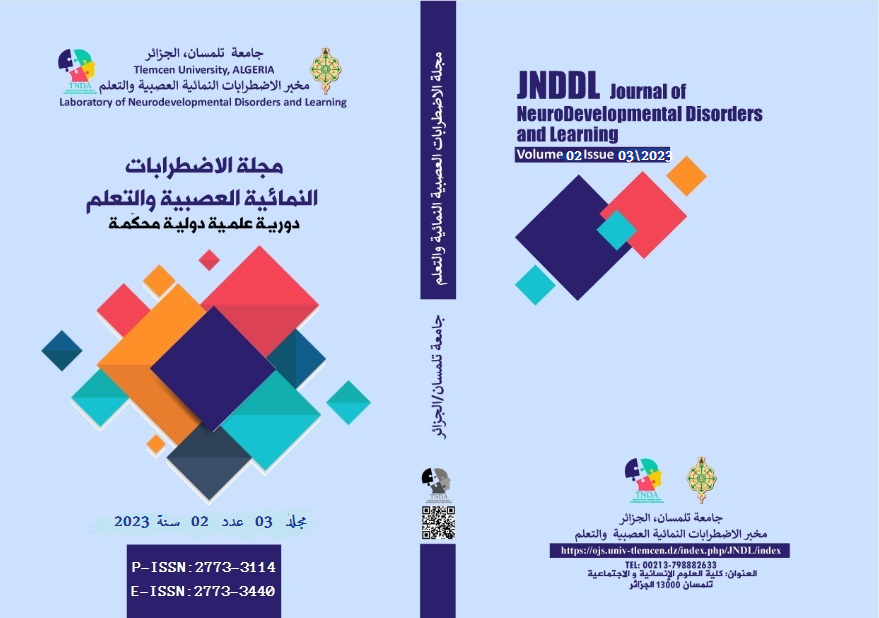مفاهيم نظرية حول التنمر الالكتروني
DOI:
https://doi.org/10.46325/jnddl.v2i2.91الكلمات المفتاحية:
intimidation - Cyberbullying - social media - electronic games - Internet users.الملخص
تسلط هذه المداخلة الضوء على الإطار النظري لظاهرة اجتماعية تنامت في ظل تعدد الوسائط الالكترونية من خلال وسائل التواصل الاجتماعي والألعاب الالكترونية التي اسيئ استخدامها ألا وهي التنمر الالكتروني، حيث أصبح هذا الأخير أداة لمضايقة وازعاج الاخرين وتهديد خصوصياتهم، وعليه يمكن لهذا العمل المساهمة في نشر الوعي في أوساط رواد الفضاءات الرقمية، لغرض الارشاد والتوجيه نحو أسس التعامل الأخلاقي مع تكنولوجية الاتصالات الحديثة لضمان وقاية الحياة الخاصة لأفراد المجتمع، من خلال الإجابة على التساؤلات التالية:
- ماهي ظاهرة التنمر الالكتروني؟
- ماهي الاشكال الأكثر انتشارا لظاهرة التنمر الالكتروني؟
- ماهي اثار ظاهرة التنمر الالكتروني؟
- ماهي طرق مواجهة ظاهرة التنمر الالكتروني؟
المراجع
القران الكريم.
أبو الديار، مسعد. (2012). سيكولوجية التنمر بين النظرية والتطبيق، الكويت، مكتبة الفلاح.
درويش، عمرو محمد أحمد، والليثي، أحمد حسن محمد (2017)، فاعلية بيئة تعلم معرفي/ سلوكي قائمة على
الدسوقي، مجدي محمد. (2016). مقياس التعامل مع السلوك التنمري، القاهرة: دار جوانا للنشر والتوزيع.
رمضان، عاشور حسين. (2016). البنية العاملية لمقياس التنمر الإلكتروني كمل تدركها الضحية لدى عينة من المراهقين. المجلة العربية لدراسات وبحوث العلوم التربوية والإنسانية، العدد4.
المفضلات الاجتماعية في تنمية استراتيجيات مواجهة التنمر الإلكتروني لطلاب المرحلة الثانوية، القاهرة، جامعة حلوان، العلوم التربوية عدد (4)، مجلد(1).
Ansary, N. S. (2020). Cyberbullying: Concepts, theories, and correlates informing evidence-based best practices for prevention. Aggression and Violent Behavior, 50, 101343. https://doi.org/10.1016/j.avb.2019.101343
Bhat, C. S. (2008). Cyber bullying: Overview and strategies for school counsellors, guidance officers, and all school personnel. Australian Journal of Guidance and Counselling, 18(1), 53–66. https://doi.org/10.1375/ajgc.18.1.53
Chehab, Y., Levasseur, C., & Bowen, F. (2016). De l’école au cyberespace, le phénomène de l’intimidation en ligne chez les jeunes : état de la recherche et de l’intervention. McGill Journal of Education, 51(1), 495–515. https://doi.org/10.7202/1037356ar
Dehue, F., C. Bolman et T. Völlink (2008). « Cyberbullying: Youngsters’ Experiences and
Parental Perception », Cyberpsychology & Behavior, vol. 11, no 2, 217-223.
Delfabbro,P.,Winefield,T.,Trainor,S.,Dollard ,S.,Metzerm,J. ----Hammarstrom,A(2006).Peer and teacher bulling/victimization of South Australian secondary school students :prevalence and psychological profiles. British journal of Educational Psychology, 79(1), 71-90
Denmark, J. (2014). Cvberbullving as a peer process: Perspectives from the preteen student. A doctoral dissertation, Walden University.
Grinshteyn, E., & Yang, Y. T. (2017). The Association between Electronic Bullying and School Absenteeism among High School Students in the United States. Journal of School Health, 87(2), 142–149. https://doi.org/10.1111/josh.12476 https://cdn.ymaws.com/www.safestates.org/resource/resmgr/imported/educatorsguide.pdf
Olivier, D. F. (2015). Cyberbullying : A Literature Review Cyberbullying : A Literature Review Buffy Sue Fegenbush University of Louisiana at Lafayette St. Mary Parish School System Department of Educational Foundations and Leadership University of Louisiana at Lafayette Paper. January 2009.
Quintin, J., Jasmin, E., & Théodoropoulou, E. (2016). La cyber intimidation chez les jeunes : mieux comprendre pour mieux intervenir à l’école. Service Social, 62(1), 1–23. https://doi.org/10.7202/1036332ar
Patchin, J.W., et S. Hinduja (2010). « Cyberbullying and self-esteem », Journal of School Health, vol. 80, no 12, p. 614-621. https://doi.org/10.1111/j.1746-1561.2010.00548
Patchin, J.W. (November 26, 2016). 2016 Cyberbullying Data. https://cyberbullying.org/2016-cyberbullying-data.consulté le 09-03-2022 sur URL.
Pearce, N., Cross, D., Monks, H., Waters, S., & Falconer, S. (2011). Current evidence of best practice in whole-school bullying intervention and its potential to inform cyberbullying interventions. Australian Journal of Guidance and Counselling, 21(1), 1–21. https://doi.org/10.1375/ajgc.21.1.1
Slonje, R., et P.K. Smith (2008). Cyberbullying: Another main type of Bullying?.Scandinavian Journal of Psychology, 49)2(, 147-154. https://doi.org/10.1111/j.1467-9450.2007.00611
Smith, P. K., Mahdavi, J., Carvalho, M., Fisher, S., Russell, S., & Tippett, N. (2008). Cyberbullying: Its nature and impact in secondary school pupils. Journal of Child Psychology and Psychiatry and Allied Disciplines, 49(4), 376–385. https://doi.org/10.1111/j.1469-7610.2007.01846.x
UNICEF. )5 février 2019(. L’actualité mondial un regard humain. https://news.un.org/fr/story/2019/02/1035651.
Van Geel, M., Vedder, P., & Tanilon, J. (2014). Relationship between peer victimization, cyberbullying, and suicide in children and adolescents ameta-analysis. JAMA Pediatrics, 168(5), 435–442. https://doi.org/10.1001/jamapediatrics.2013.4143
Willard, N. (2007). Educator’s Guide to Cyberbullying and Cyberthreats. Center for safe and responsible Use of the internet. http: //web archive.org /web/20110410181159/http://csriu.org/cyberbully/docs/cbcteducator.pdf

التنزيلات
منشور
إصدار
القسم
الرخصة
تنتهج مجلة JNDL سياسة المشاع الإبداعيCreative commons في تحديد طريقة استخدام البحث محددة بأسلوب نسب المصنف الغير التجاري، وعليه فهي تعطي الحرية للمؤلفين والقراء بمشاركة العمل وإمكانية البناء عليه كالتعديل أو الدمج والاضافة بشرط أن يتم:
- نسب العمل لصاحبه.
- عدم استخدام العمل لأغراض تجارية.





